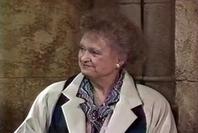
Lou Hancock
ACTRESS
Lou Hancock grew up in north Texas from Fort Worth to Nocona. Lou devoted her early life to becoming an artist and was an accomplished portrait painter. A few of her excellent canvasses survive. Lou began her acting career when she was cast to play on Broadway in a production of Kempy. She next joined the USO during WWII and toured the world. She traveled around the world and married the man next door, W. B. Hancock, DVM and reared seven children in Texas. During that time she acted in numerous off Broadway and summer stock plays at Casa Manana Theater in Fort Worth, Texas where she eventually became an associate producer. Lou auditioned for and performed in many TV shows, commercials and movies. She founded the Hip Pocket Theater in Fort Worth, Texas at George's Back Door Restaurant with Johnny and Diane Simons. At the age of sixty-five she returned to college and earned a Masters Degree in Theater from Texas Christian University where she joined the faculty as a professor and taught method acting. She moved to Los Angeles and pursued her acting full time and played numerous roles. She earned a substantial cult following in praise of her characterization of Henrietta in the movie, Evil Dead 2. She retired to Fort Worth, Texas where she landed a recurring role on the TV show, Walker, Texas Ranger as Mabel Shoop the County Clerk and C J's love interest. After three seasons she was offered a contract for a position as a permanent cast member on the show. She signed that deal but soon died of multiple myeloma before she could earn that last credit. She was a real hoofer and worked a lot. She loved show business and really had the spark of creative genius.
-
When was
Lou Hancock born?
Lou Hancock was born on Monday, February 25, 1924
-
Where was
Lou Hancock born?
Lou Hancock was born in Fort Worth, Texas, USA
-
How old was
Lou Hancock when they died?
Lou Hancock was 72
-
When did Lou Hancock die?
Lou Hancock died on
Friday, December 1, 1995
Follow Us